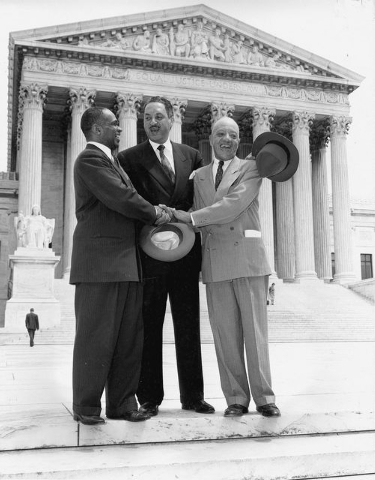60th anniversary of school segregation ban, inequality lingers

WASHINGTON — Today is the 60th anniversary of the Brown v. Board of Education decision. Many inequities in education still exist for black students and for Hispanics, a population that has grown exponentially since the 1954 ruling.
“What we’ve seen in 60 years is that the courts were able to highlight what was wrong and say stop it, but the courts by themselves do not create the moral authority and the concrete steps to make the promise of public education a reality for all children,” said Randi Weingarten, president of the American Federation of Teachers.
Here are five things to know about the case:
WHAT IS BROWN V. BOARD OF EDUCATION?
Brown v. Board of Education is a landmark case brought before the Supreme Court by the NAACP’s legal arm to challenge segregation in public schools. It began after several black families in Topeka, Kansas, were turned down when they tried to enroll their children in white schools near their homes. It was named for Oliver Brown, whose daughter Linda was barred from a white elementary school. The lawsuit was joined with cases from Delaware, South Carolina, Virginia and the District of Columbia.
On May 17, 1954, the Supreme Court ruled unanimously that separating black and white children was unconstitutional, because it denied black children the 14th Amendment’s guarantee of equal protection under the law.
“In the field of public education, the doctrine of ‘separate but equal’ has no place,” Chief Justice Earl Warren wrote. “Separate educational facilities are inherently unequal.”
The ruling overturned the court’s 1896 Plessy v. Ferguson decision, which established a “separate but equal” doctrine for blacks and whites in public facilities.
WHERE ARE THEY NOW?
Thurgood Marshall, head of the NAACP’s legal arm who argued part of the case, went on to become the Supreme Court’s first African-American justice in 1967. Marshall died in 1993. Earl Warren, a Republican and a former California governor, had been appointed chief justice of the Supreme Court the year before Brown by President Dwight Eisenhower. Warren led the court until 1969. He also chaired the Warren Commission, which investigated the assassination of President John F. Kennedy. Warren died in 1974.
Oliver Brown, for whom the case was named, became a minister at a church in Springfield, Mo. He died of a heart attack in 1961. His daughters Linda and Cheryl live in Kansas and helped found the Brown Foundation for Educational Equity, Excellence and Research.
WHAT HAVE THE COURTS SAID SINCE?
Brown v. Board of Education has never been overruled and is still in force. The Justice Department currently is a party in court to more than 180 desegregation orders with school districts nationwide.
The Supreme Court did not immediately order enforcement of its Brown decision. In 1955, Warren ordered lower courts to tell states and school districts to admit students “to public schools on a racially nondiscriminatory basis with all deliberate speed.”
However, there was resistance in the South. White parents removed their children from public schools, and officials resisted letting black children into integrated schools.
In 1968, the justices ruled in Green v. School Board of New Kent County that states operating segregated schools be ordered to come up with a system that eliminates racial discrimination “root and branch.”
In Swann v. Charlotte-Mecklenburg Board of Education in 1971, the Supreme Court endorsed sending students from different neighborhoods to the same school to promote integration, leading to the widespread use of busing to end segregation by federal judges in the South.
Many of the desegregation and busing orders have been dissolved since those decisions.
SEGREGATION TODAY
The Civil Rights Project at UCLA, using Education Department data, has found that segregation has been increasing since 1990, and that black students nationally are substantially more segregated than they were in 1970.
Around the country, only 23 percent of black students attended white-majority schools in 2011. That’s the lowest number since 1968 and far below the peak of 44 percent in 1988.
Segregation is also affecting Latino students, the largest minority group in public schools. They now are more likely to attend school with other Latinos than black students are with other blacks.
Many advocates blame this on the federal courts for removing school districts from Brown-inspired desegregation orders.
The changing demographics of school systems, including the withdrawal of white students from the public systems and the booming Latino population, also contribute to the changing colors of the schools.
DISPARITIES IN EDUCATION
Civil rights data recently released by the Education Department showed glaring disparities remain in all aspects of education. Among the findings: minority students are less likely to have access to advanced math and science classes, and to have new teachers. Black students of any age, including preschoolers, are more likely to be suspended. And, there continue to be gaps between the performance on national assessments between whites and black and Hispanic students, with whites scoring higher.
But high school graduation rates increased 15 percentage points for Hispanic students and 9 percentage points for African-American students from 2006 to 2012, according to a recent GradNation Report.
Hispanic students graduated at 76 percent and African-American students at 68 percent in 2012, the report said. The national rate is 80 percent.